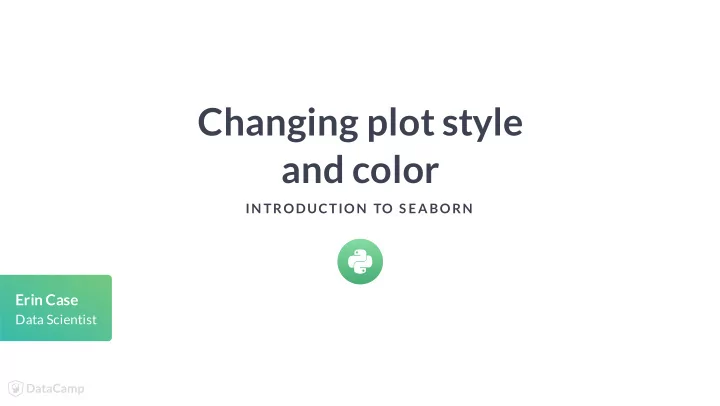

Changing plot style and color IN TRODUCTION TO S EABORN Erin Case Data Scientist
Why customize? Reasons to change style: Personal preference Improve readability Guide interpretation INTRODUCTION TO SEABORN
Changing the �gure style Figure "style" includes background and axes Preset options: "white", "dark", "whitegrid", "darkgrid", "ticks" sns.set_style() INTRODUCTION TO SEABORN
Default �gure style ("white") sns.catplot(x="age", y="masculinity_important", data=masculinity_data, hue="feel_masculine", kind="point") plt.show() INTRODUCTION TO SEABORN
Figure style: "whitegrid" sns.set_style("whitegrid") sns.catplot(x="age", y="masculinity_important", data=masculinity_data, hue="feel_masculine", kind="point") plt.show() INTRODUCTION TO SEABORN
Other styles sns.set_style("ticks") sns.catplot(x="age", y="masculinity_important", data=masculinity_data, hue="feel_masculine", kind="point") plt.show() INTRODUCTION TO SEABORN
Other styles sns.set_style("dark") sns.catplot(x="age", y="masculinity_important", data=masculinity_data, hue="feel_masculine", kind="point") plt.show() INTRODUCTION TO SEABORN
Other styles sns.set_style("darkgrid") sns.catplot(x="age", y="masculinity_important", data=masculinity_data, hue="feel_masculine", kind="point") plt.show() INTRODUCTION TO SEABORN
Changing the palette Figure "palette" changes the color of the main elements of the plot sns.set_palette() Use preset palettes or create a custom palette INTRODUCTION TO SEABORN
Diverging palettes INTRODUCTION TO SEABORN
Example (default palette) category_order = ["No answer", "Not at all", "Not very", "Somewhat", "Very"] sns.catplot(x="how_masculine", data=masculinity_data, kind="count", order=category_order) plt.show() INTRODUCTION TO SEABORN
Example (diverging palette) sns.set_palette("RdBu") category_order = ["No answer", "Not at all", "Not very", "Somewhat", "Very"] sns.catplot(x="how_masculine", data=masculinity_data, kind="count", order=category_order) plt.show() INTRODUCTION TO SEABORN
Sequential palettes INTRODUCTION TO SEABORN
Sequential palette example INTRODUCTION TO SEABORN
Custom palettes custom_palette = ["red", "green", "orange", "blue", "yellow", "purple"] sns.set_palette(custom_palette) INTRODUCTION TO SEABORN
Custom palettes custom_palette = ['#FBB4AE', '#B3CDE3', '#CCEBC5', '#DECBE4', '#FED9A6', '#FFFFCC', '#E5D8BD', '#FDDAEC', '#F2F2F2'] sns.set_palette(custom_palette) INTRODUCTION TO SEABORN
Changing the scale Figure "context" changes the scale of the plot elements and labels sns.set_context() Smallest to largest: "paper", "notebook", "talk", "poster" INTRODUCTION TO SEABORN
Default context: "paper" sns.catplot(x="age", y="masculinity_important", data=masculinity_data, hue="feel_masculine", kind="point") plt.show() INTRODUCTION TO SEABORN
Larger context: "talk" sns.set_context("talk") sns.catplot(x="age", y="masculinity_important", data=masculinity_data, hue="feel_masculine", kind="point") plt.show() INTRODUCTION TO SEABORN
Let's practice! IN TRODUCTION TO S EABORN
Adding titles and labels: Part 1 IN TRODUCTION TO S EABORN Erin Case Data Scientist
Creating informative visualizations INTRODUCTION TO SEABORN
FacetGrid vs. AxesSubplot objects Seaborn plots create two different types of objects: FacetGrid and AxesSubplot g = sns.scatterplot(x="height", y="weight", data=df) type(g) > matplotlib.axes._subplots.AxesSubplot INTRODUCTION TO SEABORN
An Empty FacetGrid INTRODUCTION TO SEABORN
FacetGrid vs. AxesSubplot objects Object Type Plot Types Characteristics relplot() , catplot() Can create subplots FacetGrid scatterplot() , countplot() , etc. Only creates a single plot AxesSubplot INTRODUCTION TO SEABORN
Adding a title to FacetGrid g = sns.catplot(x="Region", y="Birthrate", data=gdp_data, kind="box") g.fig.suptitle("New Title") plt.show() INTRODUCTION TO SEABORN
Adjusting height of title in FacetGrid g = sns.catplot(x="Region", y="Birthrate", data=gdp_data, kind="box") g.fig.suptitle("New Title", y=1.03) plt.show() INTRODUCTION TO SEABORN
Let's practice! IN TRODUCTION TO S EABORN
Adding titles and labels: Part 2 IN TRODUCTION TO S EABORN Erin Case Data Scientist
Adding a title to AxesSubplot FacetGrid AxesSubplot g = sns.catplot(x="Region", g = sns.boxplot(x="Region", y="Birthrate", y="Birthrate", data=gdp_data, data=gdp_data) kind="box") g.fig.suptitle("New Title", g.set_title("New Title", y=1.03) y=1.03) INTRODUCTION TO SEABORN
Titles for subplots g = sns.catplot(x="Region", y="Birthrate", data=gdp_data, kind="box", col="Group") INTRODUCTION TO SEABORN
Titles for subplots g = sns.catplot(x="Region", y="Birthrate", data=gdp_data, kind="box", col="Group") g.fig.suptitle("New Title", y=1.03) INTRODUCTION TO SEABORN
Titles for subplots g = sns.catplot(x="Region", y="Birthrate", data=gdp_data, kind="box", col="Group") g.fig.suptitle("New Title", y=1.03) g.set_titles("This is {col_name}") INTRODUCTION TO SEABORN
Adding axis labels g = sns.catplot(x="Region", y="Birthrate", data=gdp_data, kind="box") ` g.set(xlabel="New X Label", ylabel="New Y Label") plt.show() INTRODUCTION TO SEABORN
Rotating x-axis tick labels g = sns.catplot(x="Region", y="Birthrate", data=gdp_data, kind="box") plt.xticks(rotation=90) plt.show() INTRODUCTION TO SEABORN
Let's practice! IN TRODUCTION TO S EABORN
Putting it all together IN TRODUCTION TO S EABORN Erin Case Data Scientist
Getting started T o import Seaborn: import seaborn as sns T o import Matplotlib: import matplotlib.pyplot as plt T o show a plot: plt.show() INTRODUCTION TO SEABORN
Relational plots Show the relationship between two quantitative variables Examples: scatter plots, line plots sns.relplot(x="x_variable_name", y="y_variable_name", data=pandas_df, kind="scatter") INTRODUCTION TO SEABORN
Categorical plots Show the distribution of a quantitative variable within categories de�ned by a categorical variable Examples: bar plots, count plots, box plots, point plots sns.catplot(x="x_variable_name", y="y_variable_name", data=pandas_df, kind="bar") INTRODUCTION TO SEABORN
Adding a third variable (hue) Setting hue will create subgroups that are displayed as different colors on a single plot. INTRODUCTION TO SEABORN
Adding a third variable (row/col) Setting row and/or col in relplot() or catplot() will create subgroups that are displayed on separate subplots. INTRODUCTION TO SEABORN
Customization Change the background: sns.set_style() Change the main element colors: sns.set_palette() Change the scale: sns.set_context() INTRODUCTION TO SEABORN
Adding a title Object Type Plot Types How to Add Title relplot() , catplot() FacetGrid g.fig.suptitle() scatterplot() , countplot() , etc. AxesSubplot g.set_title() INTRODUCTION TO SEABORN
Final touches Add x- and y-axis labels: g.set(xlabel="new x-axis label", ylabel="new y-axis label") Rotate x-tick labels: plt.xticks(rotation=90) INTRODUCTION TO SEABORN
Let's practice! IN TRODUCTION TO S EABORN
Well done! What's next? IN TRODUCTION TO S EABORN Erin Case Data Scientist
Where does Seaborn �t in? INTRODUCTION TO SEABORN
Where does Seaborn �t in? INTRODUCTION TO SEABORN
Next Steps: Explore and communicate results Next steps: Seaborn advanced visualizations Matplotlib advanced customizations INTRODUCTION TO SEABORN
Next steps: Gather data Next steps: Python SQL INTRODUCTION TO SEABORN
Next steps: Transform and clean Next steps: Getting data into Pandas DataFrames Cleaning data Transforming into tidy format INTRODUCTION TO SEABORN
Next steps: Analyze and build models Next steps: Statistical analysis Calculating and interpreting con�dence intervals INTRODUCTION TO SEABORN
Congratulations! IN TRODUCTION TO S EABORN
Recommend
More recommend